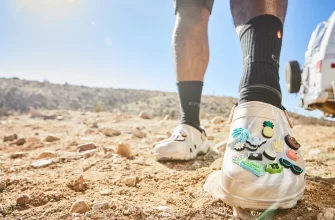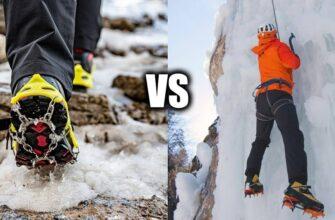If you like to enjoy the beauty of nature, you can go to the hiking trail. However, you must be comfortable on the road. Therefore, you need to choose the right shoes. More about how to size hiking boots can be read below.

- Options when choosing a hiking shoe
- Hike type
- Weather
- Terrain
- Types of hiking boots
- Sneakers
- Hiking boot for day hikes
- Boots for hikers
- Rules for wearing hiking boots
- How to size hiking boots
- Points of contact
- Socks
- Functions of hiking boots
- Ease
- Breathability
- Environmental friendliness
- How to select the right hiking boots?
- Features of fit hiking boots
- Selection of shoes for a hike: measuring the length of the foot
- Buying larger shoes
- Features of fitting hiking boots
- Simulation of real conditions
- Heel support while walking
- Enough room for fingers
- FAQ
- How to size hiking boots?
- Is it better for hiking boots to be bigger or smaller?
- Are hiking boots the same size as shoes?
- How much room should you have in hiking boots?
- Results
Options when choosing a hiking shoe
Before proceeding to the study of the question of how to size hiking shoes, it should be noted that the identical load will not always await you. Therefore, hiking shoes should be chosen based on exactly where you plan to go. More details about all the options for selection are described below.
Hike type
The first step is to determine what type of walking you are doing. If you are planning to walk on classic and long trails, look for trail running shoes that have excellent ankle support and flexible soles.
If you plan to walk for a short time, then you can stop at a light pair of hiking boots. They do not protect your ankle as much, but the sole has additional flexibility. This combines safety and comfort while walking.
Weather
If you like to travel, then adverse weather conditions do not a hindrance to you. However, this is an important factor that you need to rely on when choosing hiking shoes.
If you are traveling in a region with high levels of humidity, select waterproof boots.
If you are hiking in the desert, you can opt for hiking shoes made from breathable materials. You should also ensure that the material is resistant to the aggressive effects of ultraviolet radiation.
Terrain
Particular attention should be paid to the type of terrain where the hiking trail is located. If the ground contains a lot of stones, then a massive and not-so-flexible sole may be appropriate. This protects the feet from constant contact with the stones.
If you are walking along a sandy path, choose models with a cutout. They are designed for use in sandy conditions and have a special protective collar on the ankle.

Types of hiking boots
On the market, there is a large assortment of styles of hiking shoes. It may differ in style, as well as certain operating conditions.
Sneakers
This option is optimal if you prefer to arrange light hiking or jogging during the day over rough terrain. Visually, they resemble regular models that have a low top. However, remember that they differ in purpose.
Hiking shoes are designed for walking on rugged terrain or uneven terrain. They protect and support your feet from uncomfortable pressure points. Therefore, you do not get tired quickly, and your feet tend to be comfortable.
Hiking boot for day hikes
If you prefer to walk during the day, you can stop by these models. Day hiking boots provide ankle support and are the best option for both intense and short backpacking trips.
Boots for hikers
Such models are specially designed to keep your ankles comfortable. Therefore, even after a few days of travel, your legs do not get tired. Even if you carry heavy backpacks.
Such stiff boot, designed for multi-day hikes, has a hardliner in the sole. Therefore, the legs do not get tired quickly, even if you walk on rocky terrain.

Rules for wearing hiking boots
Once you’ve chosen the right hiking shoes for yourself, you’ll need to pair them with your other pieces of clothing in the right way. More details about feet measured and other tips for your outdoor adventures you may find below.
How to size hiking boots
When you move, your legs tend to swell. Therefore, try to select shoes with a toe box that is 0,5-1 size larger than your longest toe. It is better to choose loose hiking boots than tight ones. This not only improves comfort but also helps preserve health.
Points of contact
Hiking boots and shoes should not create pressure points on the foot forward.
If during the fitting you feel discomfort, be prepared that during walks in nature, it is intensifying.
Therefore, it is impossible for there to be pressure on the foot.
Socks
For a walk to be enjoyable, it is important to pair your hiking boots with the right socks. Choose thick socks that are specifically designed for hiking. They have a dense structure; however, they pass air better.

Functions of hiking boots
It is important to note that not all hiking boots are comfortable and of high quality. Some models have additional features that help ensure a comfortable journey.
Ease
If you walk a little in heavy backpacking boots, the time drags on much longer. Therefore, try to give preference to lightweight models that meet all your requirements. Believe me, you will be satisfied with the purchase.
Breathability
If your feet sweat, then the likelihood of calluses only increases. Additionally, you encounter an unpleasant odor. Try to opt for hiking boots that are made of breathable materials.
This provides good ventilation. Even if the hike is intense, the feet are dry, without an unpleasant odor.
Environmental friendliness
Almost all models of hiking boots and shoes that are on the market are made of synthetic materials. Therefore, the hiking boots you throw away lie in a landfill for years and harm the environment.
If you care about nature, try to choose a light pair of hiking boots. Choose manufacturers that work with biodegradable materials. This allows you to save nature and take care of your health.

How to select the right hiking boots?
Regardless of the material of the shoe, you must understand and feel that hiking boots fit you in size. It should be noted that size matching is largely determined by the materials used in production.
It is believed that models with leather lining fit the foot better when compared to lining made of textile or waterproof material.
The skin tends to adapt quickly, so you need to opt for the size very carefully, the hiking boots should fit you. Even if you wear and lace up your hiking boot correctly, the hike may not be very successful. After all, shoes may initially not suit you.
Features of fit hiking boots
Particular attention should be paid to the quality of the block. Often, a foot model made of wood or plastic is taken as the basis. The shape of the last corresponds to the fit hiking boots.
All manufacturers differ in certain styles of pads. Some people tend to use different last options for each hiking shoe. If a certain model does not suit you, you can choose another one. Be aware that there are limitations that may dictate the fit of a hiking boot.
HANWAG produces each hiking boot with different lasts so that each customer can select the best option for themselves. In total, 5 types of pads are used, namely:
- Wide Last. It is an ideal solution for those with wide feet;
- Bunion Last. It is ideal for people who have a bone deformity or hallux valgus;
- Fit Last. It provides space in the toe area;
- StraightFit Extra Last. It comes with more space in the toe area than the previous model;
- Narrow shoe. It is suitable for narrow feet;
- Alpine Wide Last. It has extra capacity.
The use of special pads benefits your feet. If you are buying hiking boots and shoes of high quality, they fit your foot shape. And you don’t have to waste time looking for another model.
There are pads suitable for men or women. Therefore, each buyer can select the best option for him or her.

Selection of shoes for a hike: measuring the length of the foot
If you prefer to buy in a specialized store, you can ask for help from consultants to help you choose the optimal size. You can also try on different models and sizes to make your choice easier.
If you prefer to shop online, you need to measure your foot length yourself. To do this, you need to put your foot on a piece of paper, and put marks at the level of the heels and thumb. After the segment, measure with a ruler, and compare the data obtained with the dimensional grid.

Buying larger shoes
Everyone knows their shoe size. If you are not one of them, then the measurement instructions were presented a little earlier. Experienced consultants advise buying hiking shoes 1 size larger than yours. On average, the distance from the toes to the toe of the hiking boot should be a toe.
The larger toe box prevents your toes from hitting the front of the hiking boot as you move. Otherwise, the thumb constantly moves away from the walls of the shoes, which will cause pain and discomfort. This can lead to black nails and infections.
If you choose high-quality shoes, the upper of which is made of textiles, then the fit should be long. You have to choose shoes a half size larger.

Features of fitting hiking boots
If you decide to buy a quality model of hiking boots and shoes, then this should be done only after trying them on. Even if you are sure that you have chosen the right shape and size of shoes, the fitting will never be superfluous. You need to follow a few tips, namely:
- It is recommended to try on shoes from lunch to evening. During the day, the legs swell, as with a hike. If you buy shoes in the morning, they may be tight by the evening.
- Try on shoes with hiking socks.
- Do not make rash purchases. If during the fitting, your hiking boots feel pressure or stable discomfort, you should not be buying hiking boots. Better find another model.
Simulation of real conditions
Specialty stores have a special area for testing shoes, which is complemented by imitation of various terrains and ramps. Walk around a little in the shoes to see if they are suitable for the hike.
If you bought shoes online and try them on at home, try to simulate the conditions at home. Make sure that your fingers do not hit the front part of the backpacking boots. Especially when you are simulating a descent.

Heel support while walking
If your heel slips and moves, there is a good chance that you run into blisters on your hike. To test the fit snug, try on the boots without tying the laces.
If you feel a lot of free space on the side, then the heel is too wide and does not suit you.
After you can lace up your shoes, and stand on the step with only a toe. If the heel moves as you move, discard the purchase. If it is fixed, then the hiking boot fit you perfectly.
Enough room for fingers
Your fingers should move freely, not only forward, but also to the sides. If your feet are tightly fitted with shoes, then you risk frostbite. As for hiking boots, the situation is a little different.
You should make sure that you fit hiking boots snugly to the leg, however, not much. Otherwise, during the ascent and contact with the rock, you may experience discomfort.

FAQ
When it comes to choosing hiking boots, there are a lot of questions to ask.
How to size hiking boots?
It is possible to accurately determine the size of hiking boots that suits you only after trying them on.
Is it better for hiking boots to be bigger or smaller?
As already mentioned, during the hike, the feet swell. Therefore, it is better to select hiking boots a size larger than smaller.
Are hiking boots the same size as shoes?
No, the size of your hiking boots is different from the shoes you wear hiking every day. It is better to choose a model at least a half size larger than your foot length.
How much room should you have in hiking boots?
On average, there should be about 0,25 inches in between the toes and the toe of the new boots. This prevents the formation of blisters, and you are more pleasant covering long distances.
Results
As you can see, choosing hiking boots is extremely difficult. You have to take into account many factors to make the trip comfortable and safe.



![What is considered a long hike? [8 factors to consider] What Is Considered A Long Hike: Top 3 Tips & Best Guide](https://griffithparkhiker.com/wp-content/uploads/2024/01/griffithparkhiker-2-335x220.jpg)





